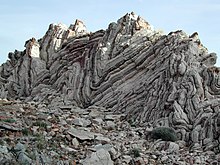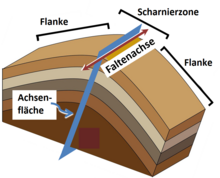Fold (geology)

A fold is the bending or curvature of one or more geological interfaces such as the stratification of sedimentary rocks or the contact surfaces of an igneous dike with its neighboring rock. Folding is the process of fold formation, but in regional and historical geology it also describes mountain-forming events that can be separated from one another . A fold can be regional or macroscopic.
When folded, rock layers are usually deformed in waves by pressure from the outside. According to the mechanical behavior of the rock layers when folding, one differentiates:
- competent rocks ; mostly thick-banked, hard rock layers that offer massive resistance to deformation and therefore only change their thickness only minimally even with high lateral pressure, for example limestone
- incompetent rocks ; plastic, easily deformable clay , marl or salt layers
If a sedimentary rock with alternating competent and incompetent layers is deformed, part of the incompetent matrix “flows” into the fold hinges.
At relatively homogeneous substrate to form bending folds arise at widely varying in strength layers Scherf elderly or small-scale movements in very mobile rock such as magma melt flow wrinkles . However, the rock must have a certain degree of heterogeneity in order for the fold to be visible at all. Due to their formation, chronological sequence or form, folds in an area that belong together are called a fold system. The term folding system is furthermore used as a synonym for fold mountains or fold belt .
Description of the fold
- Hinge : Smallest radius, often found at the apex, but does not necessarily have to be there
- Vertex (point) : highest point of a fold
- Trough : lowest point of a fold
- Turning point or bending point : transition from one fold to the other
- Leg or Flank : Area between the vertex and the inflection point
- In the case of tilted folds, the two legs can be divided into front legs (the shorter), back legs (the longer).
- Hinge line, fold axis : connection between at least 2 folds, allows spatial classification of the fold
- Fold axis plane or fold axis surface: forms the surface that connects the hinge lines of different layers
- Vergence : Indicates the direction in which an asymmetrical (a fold that is tilted in one direction) is inclined. Symmetrical folds have no vergence.
- Opening angle: describes the angle between the two bending points.
Antiform and synform or syncline and anticline
The fold can be open at the top (Synform) or at the bottom (Antiform). Both terms describe the shape.
However, the terms syncline and anticline mainly describe the age of the rock that lies on the inside of the fold. The deposition takes place according to the stratigraphic principle , thereby younger layers are deposited higher up. In the case of an antiform, the older layer comes to lie on the inside (anticline antiform), in the case of a synform, the younger layer comes to lie on the inside (synclinal synform). If the age sequence is from top to bottom (e.g. through thrusts), the relationships in the fold change. If the age sequence is reversed, therefore the antiform has young material in the core, one speaks of an antiform syncline and the synform of older material in the core of the fold is called a synform anticline.

Parasitic wrinkles
Parasitic folds or second-order folds are smaller folds within a larger fold. As a result, it is possible to draw a conclusion about the fold of the 1st order due to the parasitic fold. Parasitic folds can be divided into Z, M, and S folds because they look similar to these letters. The vergence occurs clockwise with Z-folds, counterclockwise with S-folds and the M-folds are symmetrical (no vergence).
See also
literature
- Gerhard H. Eisbacher: Introduction to Tectonics . 1st edition. Ferdinand Enke Verlag, Stuttgart 1991, ISBN 3-432-99251-3 , pp. 104 ff .
Individual evidence
- ↑ Structural Geology 2017 (pdf) ETH Zurich . S. 230. 2017. Accessed October 30, 2019 ..
Web links
- Detailed and illustrated description of wrinkles at mineralienatlas.de
- Fold at lexikon.meyers.de ( Memento from January 31, 2008 in the Internet Archive )
- Jean-Pierre Burg: Wrinkles . (PDF file; 2.35 MB) Geological Institute, Structural Geology and Tectonics Working Group, ETH Zurich and University of Zurich



